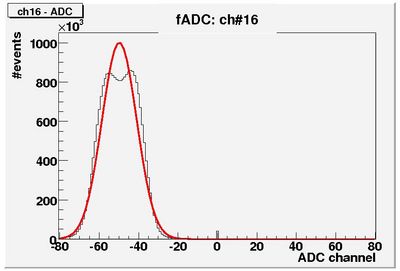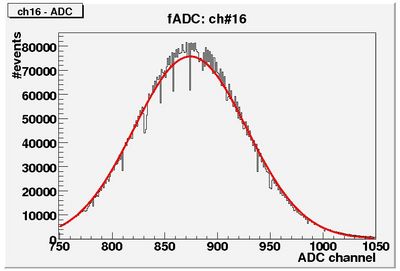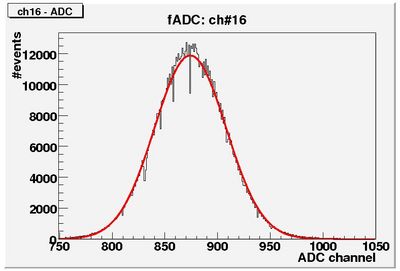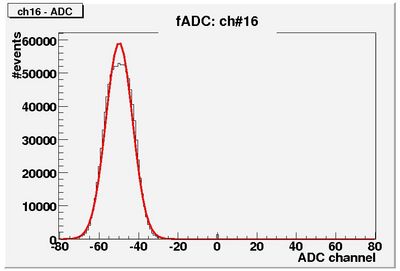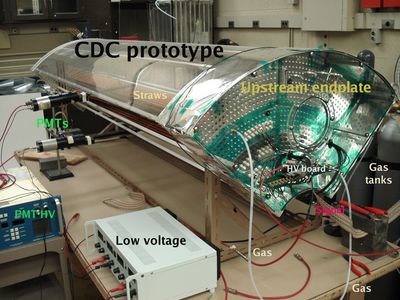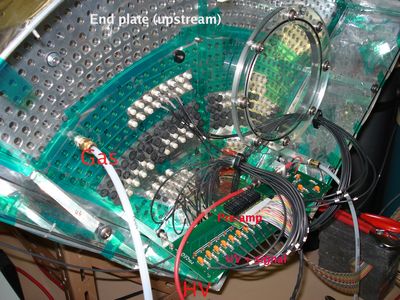Difference between revisions of "CDC"
(→Status Report on the CDC from 21 November 2007: Noise Studies) |
|||
| Line 35: | Line 35: | ||
Now that we have established a reference, we can talk about the impact of placing the electronics outside the CDC (as will be done in the final design). The first observation was an incredible increase in noise (on the scope, no plots unfortunately). After trying out a lot of configurations it was found that one ground connection from the HV-Distribution-Board (HDB) to the CDC upstream endplate is not enough (it was enough when the HDB was inside the CDC). A couple more connections between the HDB-ground and the CDC-upstream-endplate where made (picture later) and again a pedestal measurement was taken. The result of this measurement can be seen in figure 3. [[Image:ADC_pedestals_no_cmnsub.jpg|thumb|none|400px|Figure 3: Pedestal of channel 16.]] | Now that we have established a reference, we can talk about the impact of placing the electronics outside the CDC (as will be done in the final design). The first observation was an incredible increase in noise (on the scope, no plots unfortunately). After trying out a lot of configurations it was found that one ground connection from the HV-Distribution-Board (HDB) to the CDC upstream endplate is not enough (it was enough when the HDB was inside the CDC). A couple more connections between the HDB-ground and the CDC-upstream-endplate where made (picture later) and again a pedestal measurement was taken. The result of this measurement can be seen in figure 3. [[Image:ADC_pedestals_no_cmnsub.jpg|thumb|none|400px|Figure 3: Pedestal of channel 16.]] | ||
| − | One can see again a broad Gaussian pedestal. After subtracting the CMN there was still this double peak structure for some of the channels. This was investigated by swapping around cables, etc. and it turned out that this was due to some bad LEMO cables going from the differential fan-out to the fADCs. The LEMO cables that are used now are more than 20 years old and have (according to me) a weak spot right behind the connector. We were able to find good ones to work with for now, but new ones will be ordered. The noise peak after changing the LEMO cables can be seen in figure 4. [[Image:ADC_pedestals_cmnsub.jpg|thumb|none|400px|Figure 4: Pedestal of channel 16, CMN subtracted.]] | + | One can see again a broad Gaussian pedestal. After subtracting the CMN there was still this double peak structure for some of the channels. This was investigated by swapping around cables, etc. and it turned out that this was due to some bad LEMO cables going from the differential fan-out to the fADCs. The LEMO cables that are used now are more than 20 years old and have (according to me) a weak spot right behind the connector. We were able to find good ones to work with for now, but new ones will be ordered. The noise peak (CMN subtracted) after changing the LEMO cables can be seen in figure 4. [[Image:ADC_pedestals_cmnsub.jpg|thumb|none|400px|Figure 4: Pedestal of channel 16, CMN subtracted.]] |
There is an increase in the width of the pedestal compared to the situation where the HDB was inside the CDC but after CMN subtraction the width of the pedestals is more or less the same. In order to try to reduce this, 2 more connections between HDB-ground and the CDC-upstream-endplate were made and the result can be seen in figure 5. [[Image:ADC_pedestals_no_cmnsub_moreground.jpg|thumb|none|400px|Figure 4: Pedestal of channel 16 with more HDB-ground CDC-upstream-endplate connections.]] | There is an increase in the width of the pedestal compared to the situation where the HDB was inside the CDC but after CMN subtraction the width of the pedestals is more or less the same. In order to try to reduce this, 2 more connections between HDB-ground and the CDC-upstream-endplate were made and the result can be seen in figure 5. [[Image:ADC_pedestals_no_cmnsub_moreground.jpg|thumb|none|400px|Figure 4: Pedestal of channel 16 with more HDB-ground CDC-upstream-endplate connections.]] | ||
| Line 41: | Line 41: | ||
Conclusion: we have to think about proper grounding for the final design. | Conclusion: we have to think about proper grounding for the final design. | ||
| − | |||
==Status Report on the CDC from 14 November 2007== | ==Status Report on the CDC from 14 November 2007== | ||
Revision as of 17:33, 24 November 2007
The GlueX Central Drift Chamber
The CDC is a straw tube chamber that sits around the target in the GlueX experiment. The straws nominally run parallel to the beamline with readout on the upstream end of the chamber. About 30% of the straws are tilted with a 6 degree stereo angle to provide a measurement of the z position in two regions along the track. Tracks going more forward than about 30 degrees will also be tracked by the forward drift chamber system in the GlueX detector ( FDC ).
The 1.6cm diameter straws are arranged in 25 radial layers. The inner-most layer is at about 10cm and the outermost is at about 58cm from the beamline. The chamber is anticipated to achieve a 150 micron position resolution in the r-phi plane, which when conbined with the stereo information will yield a number of z measurements with resolution of about a mm.
The most up-to-date description of the CDC is found in GlueX-document 737 which can be found on the portal http://portal.gluex.org . There were also changes to this design that have been documents in GlueX-doc 744 and in document number 764 is the budget justification information for the chamber. All older documents should be considered out of date and probably inaccurate.
The CDC is being built by the Medium Energy Physics group at Carnegie Mellon University http://www.cmu.edu . The current members of the CMU group involved in this effort are:
- ) Curtis A. Meyer cmeyer@ernest.phys.cmu.edu
- ) Gregg Franklin gbfranklin@cmu.edu
- ) Yves Van Haarlem yvhaarle@ernest.phys.cmu.edu
- ) Matt Bellis bellis@ernest.phys.cmu.edu
- ) Gary Wilkin wilkin@ernest.phys.cmu.edu
Status Report on the CDC from 21 November 2007: Noise Studies
Now that all the electronics are mounted outside (see previous status report) it is possible to study the noise. Where should we start? Let's start by taking a reference, in figure 1, one can see a fit pedestal from channel 16 (= channel 8 on the second 200 MHz fADC) taken at the time before all electronics where moved out of the CDC. One sees a relatively broad Gaussian pedestal. Looking at the signals on the oscilloscope it was observed that the noise more or less looked the same on all channels. In order to subtract this common noise, a very simple common noise (CMN) subtraction algorithm was applied: the average "signal" of all straws, connected to same fADC, was subtracted from the original signal. In the future a more complex algorithm can be applied, if necessary. The result of this CMN subtraction is shown in figure 2. Waw, the width of the noise-peak is reduced by almost a factor of 3! One can also see a double peak structure, we'll come back to this later. Now that we have established a reference, we can talk about the impact of placing the electronics outside the CDC (as will be done in the final design). The first observation was an incredible increase in noise (on the scope, no plots unfortunately). After trying out a lot of configurations it was found that one ground connection from the HV-Distribution-Board (HDB) to the CDC upstream endplate is not enough (it was enough when the HDB was inside the CDC). A couple more connections between the HDB-ground and the CDC-upstream-endplate where made (picture later) and again a pedestal measurement was taken. The result of this measurement can be seen in figure 3. One can see again a broad Gaussian pedestal. After subtracting the CMN there was still this double peak structure for some of the channels. This was investigated by swapping around cables, etc. and it turned out that this was due to some bad LEMO cables going from the differential fan-out to the fADCs. The LEMO cables that are used now are more than 20 years old and have (according to me) a weak spot right behind the connector. We were able to find good ones to work with for now, but new ones will be ordered. The noise peak (CMN subtracted) after changing the LEMO cables can be seen in figure 4. There is an increase in the width of the pedestal compared to the situation where the HDB was inside the CDC but after CMN subtraction the width of the pedestals is more or less the same. In order to try to reduce this, 2 more connections between HDB-ground and the CDC-upstream-endplate were made and the result can be seen in figure 5. Yes, the situation improved. If this is all common noise, then the CMN subtraction should take care of it? Apparently this is not the case because the pedestal width also reduces after CMN subtraction as can be seen in figure 6 compared to the situation before adding two ground connections.Conclusion: we have to think about proper grounding for the final design.
Status Report on the CDC from 14 November 2007
Since last week, we have mounted the chamber electronics on the outside of the chamber. We have also shifted the readout to only readout straight layers at this point in time. This will allow us to get a better handle on the chamber resolution using the 16 channels of readout that are available in the two Flash ADC units at CMU.
We have also carried out new GARFIELD calculations of the electrostatics of the chamber. We include here a field line plot ( File:GARFIELD FIELDLINES.PS ) for the current voltage and gas mixture as well as a time-to-distance relation ( File:GARFIELD-XTPLOT.PS ) which we use to convert the drift times to a distance from the wire.
Finally, Yves has started to implement a simple track finder based on the ideas of a Hough transform of the data. We are currently at the point where we need to write the track fitting algorithm which will allow us to start to extract resolution numbers from the chamber. This is based on the idea that the individual hits are represented as a small circle where we know the center (x,y) and radius r. The track needs to be tangent to all of the measured circles.

